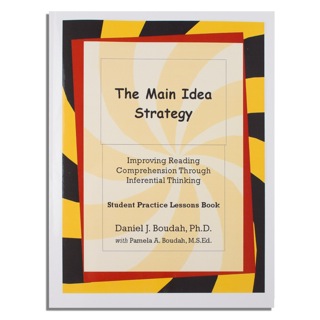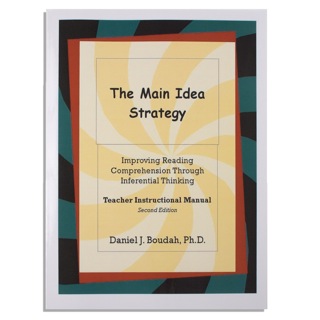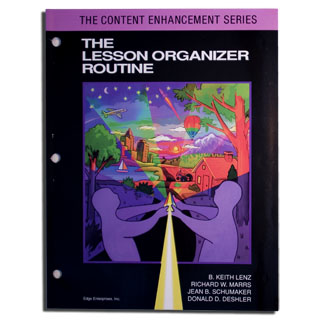Description
Research on the Test-Taking Strategy CD for Students
Study 1
Overview
The Test-Taking Strategy CD is a computerized software program for teaching the Test-Taking Strategy to students. This study was conducted with 12 students with learning disabilities. A multiple-baseline across-students design was employed. Students worked through the interactive computerized program independently.
Results
On a test of student knowledge of the strategy (this was a written test requiring open-ended responses), students earned, on average, 6% of the points available during baseline and 80% of the points available after instruction. The results of a t-test for dependent groups indicated that there was a significant difference between the average baseline and average post-instruction scores [t(11) = 21.65, p < .001]. The effect size between the pretest and posttest means (Cohen’s d formula) was .99, representing a large effect size.
On a test of student use of the strategy where students took a test and demonstrated their use of the strategy steps, students earned an average of 42% of the points available during baseline and 93% of the points available after instruction. A t-test for dependent groups revealed a significant difference between the average baseline scores and average post-instruction scores [t[11] = 23.54, p < .001]. The effect size was .97, representing a large effect size.
Conclusions
The Test-Taking Strategy CD program is an effective means of teaching the Test-Taking Strategy to students. All 12 students reached a mastery level of 90% of the strategy steps used on their second practice attempt. Students’ knowledge and use of the strategy increased significantly from baseline to post-instruction. These results are comparable to the results achieved through live instruction of the Test-Taking Strategy in studies conducted by Hughes and Schumaker (1991) and Hughes, Deshler, Ruhl, & Schumaker (1993).
Reference for This Study
Lancaster, P. E., Lancaster, S. J., Schumaker, J. B., & Deshler, D. D. (2006). The efficacy of an interactive hypermedia program for teaching a test-taking strategy to students with high-incidence disabilities. Journal of Special Education Technology, 21(2), 17-30.
Other References for the Test-taking Strategy
Hughes, C. A., Deshler, D. D., Ruhl, K. L., & Schumaker, J. B. (1993). Test-taking strategy instruction for adolescents with emotional and behavior disorders. Journal of Emotional and Behavioral Disorders, 1, 189-198.
Hughes, C. A., & Schumaker J. B. (1991). Test-taking strategy instruction for adolescents with learning disabilities. Exceptionality, 2, 205-221.
Study 2
Overview
This study was conducted in both junior and senior high schools. Eighty-eight junior-high and 82 senior-high students with learning disabilities participated. They were randomly selected into an experimental group and a control group at each level of schooling. A pretest-posttest control-group design was utilized. Students in the experimental group worked independently through the computerized program. Students in the control group completed other school work.
Results
Figure 1 displays the mean percentage of points earned by the junior- and senior-high students in each group on a test of their knowledge of the Test-Taking Strategy before and after instruction. This was a written test requiring open-ended responses. Results of a t-test showed no significant difference between the two groups on the pretest [t(110) = .819, p = .415]. A repeated-measures ANOVA revealed a significant difference between the gains made by the experimental and control groups [F(1, 110) = 297.08, p < .001] but no difference between the gains made by the junior and senior high students [F (1, 108) = .816, p = .368]. Partial eta squared was calculated at .732 for the difference between the gains of the groups, representing a large effect size (Cohen, 1969).
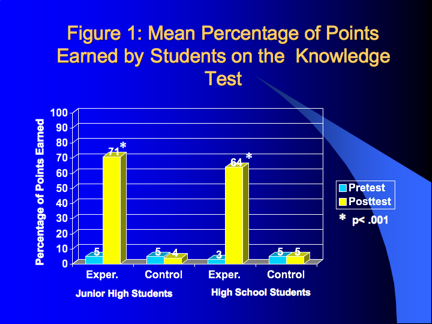
Figure 2 displays the mean percentage of points earned by the junior- and senior-high students in each group on a test of their use of the strategy steps before and after the CD instruction. Results of a t-test indicated no significant difference between the Strategy-use pretest scores of the combined experimental and control groups [t (110) = .958, p = .340]. Results of the Repeated-measures Analysis of Variance (ANOVA) indicated that there was a significant difference between the gains made by the experimental and control groups [F (1, 110) = 275.7, p < .001] but no significant difference between gains made by the junior- and senior-high students [F (1, 108) = .840 p = .362]. The effect size for the difference between the gains made by the experimental and the control groups was .792. This partial eta squared represents a large effect size according to Cohen (1969).
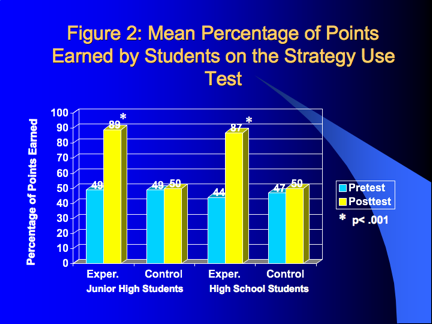
Conclusions
These results indicate that students can learn to use a complex strategy, like the Test-Taking Strategy, through the use of an interactive computerized program. Further, on average, they learned to use the strategy above the mastery level (80% or above). Both junior- and senior-high students benefited equally from their use of the program.
Reference for This Study
Lancaster, P. E., Lancaster, S. J., Schumaker, J. B., & Deshler, D. D. (2009). Effects of a computerized program on the use of the Test-Taking Strategy by secondary students with disabilities. Learning Disability Quarterly, 32(3) 165-179.
About the Author

Paula E. Lancaster, Ph.D.
Affliations
Principal Investigator
Edge Enterprises, Inc.
Lawrence, KS
Associate Professor, College of Education
Grand Valley State University
Allendale, Michigan
Research Affiliate and Certified SIM Professional Development Specialist
Department of Special Education
University of Kansas
Lawrence, KS
My Background and Interests
For as long as I can remember, I was involved in the disability field in some capacity. First, as a family member, then as a young person volunteering, I was involved with Very Special Arts, Easter Seals, and the Special Olympics. Later, when I decided to major in special education, I continued my volunteer work and became interested in learning disabilities. Today, I teach graduate courses on learning disabilities at Grand Valley State University, continue with research and development activities through Edge Enterprises, and feel blessed to have found a career path where I can honestly say that if we hit the lottery tomorrow, I would continue to do this work as a volunteer. I’m still most interested in adolescent and young-adult issues and continue to work with local organizations in an effort to improve after-school programs for secondary students. My son, JD, learned his first strategy this year, and my daughter, Ellie, has two under her belt. They are currently a huge interest of mine!
The Story Behind the Test-Taking Strategy CD
Development of the Test-Taking Strategy CD was funded by a grant from the National Institute of Child and Human Development. We were given the opportunity to create three programs for delivering strategy instruction to adolescents with high-incidence disabilities and/or low achievement. One of the primary issues we were addressing is that students who struggle to learn for various reasons often lack a repertoire of strategies that allow them to be independent, efficient, and effective learners. Further, a body of research-validated learning strategies exists, but teachers are having a difficult time finding the time and opportunity to teach them. While this CD does not completely replace the teacher, it does reduce the amount of required teacher time, freeing the teacher up to work individually with students who need individual instruction or to provide more one-on-one feedback.
The Test-Taking Strategy instruction seemed like a perfect fit for computerized instruction. All students have a frame of reference for taking tests, so they tend to be open to instruction in strategies that will help them be more successful test-takers. Instruction in the Test-Taking Strategy had been associated with improved test scores for students, and students with disabilities and low achievement were being asked to take more tests. Working with Dr. Charlie Hughes and, of course, Drs. Deshler and Schumaker (who were some of the original authors of the Test-Taking Strategy manual) was wonderful. They were very patient and supportive as we slogged through the development process, and their feedback on the scripts and initial drafts of the CD was very helpful. I didn’t know what to expect as we conducted the pilot test, but the results were wonderful! We learned so much from the 15 students and teachers who participated. We took the feedback from our consultants, students, and teachers and revised the software program for the field tests, which included approximately 200 students. Additional time was spent polishing the program after the field tests. It was reviewed carefully by Jean Schumaker and Jackie Shafer before the final copy was complete.
My Thoughts About Instruction in the Test-Taking Strategy
I have enjoyed having the opportunity to teach this strategy to many, many students and to provide professional development experiences related to this strategy to many educators. If I ever find myself with a considerable amount of time on my hands, I think taking a close look at the psychological edge that the Test-Taking Strategy provides for students would be a very interesting research project. I’m not sure exactly what such a study would look like, but the confidence factor associated with use of the strategy is very interesting to me. One of the things I’ve always liked about teaching the Test-Taking Strategy is that background knowledge is not an issue. All students know what taking a test is about, and most of the students with whom I’ve worked know what not doing well on a test is about, too. Thus, they often come to the table with an above-average willingness to learn. I also enjoy teaching students and teachers about affirmations. Most students and quite a few teachers haven’t thought about test-taking as a performance, but when I remind them what athletes, singers, or other performers do before taking the field or stage, and that test-taking is very similar, they suddenly see affirmations in a whole new light.
Teacher and Student Feedback about this Product
My conversations with students have been interesting in that students almost always focus on one specific part of the strategy that they learned. Even when I ask something like, “So, overall, what did you think?” they might say something like, “It was okay” and then go right into, “I like the part about estimating,” or “I never thought about underlining directions.” To me, that shows the immediate connections students are making to what they just learned about test-taking and what their previous test-taking habits had been. Teachers are positive about the opportunity to give their students solid test-taking skills and hopefully lessen their anxiety about the various tests they will be taking.
I also have to tell one other story. We were conducting a study in an inner-city high school in Grand Rapids. Students in the experimental group were working through the CD while trying to maintain their edgy demeanor. During a small-group interview, I asked one of the students what he thought of the program and strategy. He answered, “I can’t wait to take my next test!” His peers looked at him in amazement and said, “Dude, think about that for a minute.” “Right, right. It was good,” was his much humbler reply. I’ll be hanging on to that memory for a long time!
My Contact Information
Email: lancastp@gvsu.edu
Work Phone: 616-485-4935





